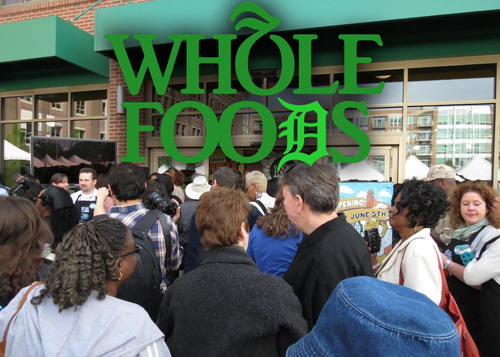The Deadline Detroit Grocery Price Challenge: How Does Whole Foods Stack Up?
 Jeff: So, Lauren, we’ve run through the same shopping list at five different grocery stores. When the dust settled, how did they rate price-wise.
Jeff: So, Lauren, we’ve run through the same shopping list at five different grocery stores. When the dust settled, how did they rate price-wise.
Lauren: Aldi is cheapest and Whole Foods in West Bloomfield is most expensive — no surprise there. Honeybee Market and University Foods landed in the middle and were close enough that I wouldn’t say one is universally cheaper. This is not a statistically significant study, after all. Personal judgment determines what salad looks nicer for lunch.
Whole Foods in Detroit was definitely cheaper than Whole Foods in West Bloomfield, but was more expensive than other Detroit options.
- Aldi: $62.07
- University Foods: $85.65
- Honeybee: $91.37
- Whole Foods Detroit: $106.32
- Whole Foods West Bloomfield: $125.52
Jeff: But the Whole Foods in Detroit wasn’t that much more expensive than Honeybee or University. I think I see two big takeaways from our little experiment–inexact, not unlike most people’s shopping habits, as it may be.
1. Midtown Whole Foods isn’t likely to price anyone out. There’s good value there if you look.
2. The store does serve a legitimate commercial need. That is, people like shopping there and working there and it means one less vacant lot off Mack. However, I’m dubious that it’s filling a social need. We found that you can get meat, fresh produce, packaged food and prepared foods in stores within reach of anyone shopping in Midtown. The real food desert is likely more of a outer neighborhood problem.
Lauren: I agree, but I would say that the “chain grocer” factor is filling a need as well.
My biggest takeaway from hanging out at Whole Foods all morning was that people are very, very excited about this. Excited enough that they’re willing to skip work, wait in line for a half hour at 10 a.m. just to get in and fill their carts. Whatever your thoughts on grocery prices and business subsidies and media hype, no one can argue this isn’t a big moment for the city. Someone had to be first.
Jeff: Oh, for sure. Any new retail option is win for Detroit. Double points for a national chain with the reputation of Whole Foods. The store offers a lot. The ability to grind your own peanut butter was kind of my favorite part of the store. What was your impression of the other stores in the city?
Lauren: They’re all pretty top-notch — I’ve shopped at each place we visited before this experiment.
Now’s actually a good time to trumpet all the other groceies in town, on our list or otherwise. Detroit gets a bad reputation for food options because of our status as a food desert, when there are a lot of quality, locally-owned grocery stores in town with tons of variety.
It’s worth noting that food desert status is given to low-income areas where the closest grocery store more than a half mile away, and Midtown was not one of these areas, even before Whole Foods arrived.
Jeff: The low-income aspect of the food desert paradigm is interesting because part of the problem, poverty, can’t be solved with more grocery stores. But people see that term and think get more grocers in Detroit is the answer. That’s really only part of the answer.
You’re right about the quality of some of the city’s local stores. Two we didn’t mention here: Ye Olde Butcher Shoppe and Metro Foodland. And I think Honeybee is on par with Avalon and Slows. Detroiters should take visitors there for tamales and guacamole. It’s that fantastic.
Lauren: Hear hear! All of Southwest really. It’s a great neighborhood.
After an entire day’s worth of visiting grocery stores and writing about food, I’m starving. I think it’s time to cook that Jambalaya.
Jeff: Agreed. Later!
This is the final piece in a series of live blog-style articles about the Midtown Detroit Whole Foods originally published on Deadline Detroit. It was co-written with Jeff Wattrick.